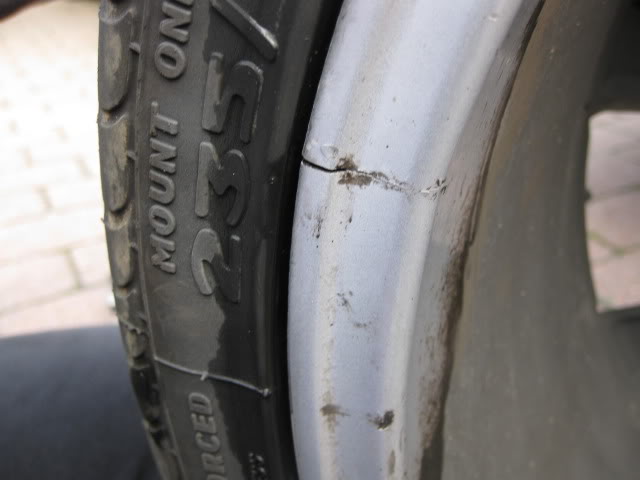Should I weld my cracked aluminium wheel?
Opinions vary wildly, from “Absolutely!” to “Nooooo!” and pretty much everything in between.
So here’s my definitive answer: Maybe.
Aluminium alloy wheels have a tendency to crack if they get hit hard enough. How hard is enough depends on a couple of factors – how brittle the alloy is, the design of the wheel and the tyre’s aspect ratio being the most important. Usually a good deep pothole or raised manhole cover is what does it. Cracks are extremely dangerous, and not just for the obvious reason that they can let the air out of your tyre. There’s also the fact that they can let the air out of your tyre very quickly and without warning.
We see people all the time who had a small crack in their wheel, one so small that it was covered and sealed by the bead of the tyre, so that the tyre was not leaking. Sometimes we would have to convince these people that the crack needed to be dealt with even though it was not an immediate problem. The issue is that a crack like that is going to grow, and it will usually not even take as hard an impact to widen it as the impact that originally caused the crack. If the crack turns to one side, or splits into a “Y” shape, there is the possibility that you could catastrophically lose an entyre chunk of wheel.
There are some important issues to take into account when deciding whether to weld a cracked wheel:
- The location of the crack: The only type of crack that we believe is even marginally safe to weld is one on the back, or inboard side of the wheel. A crack on the front face of the wheel compromises the structural integrity of the wheel, as does a crack on one of the spokes. A crack inside the barrel is also inadvisable to weld.
- The direction of the crack: Most of the time, a crack on the back side of the wheel will cross the flange and bead area at right angles to the direction the wheel spins. This type of crack can be welded, because it can be opened up to accept the weld. A crack that goes parallel to the spin direction should not be welded, because it will usually cause the wheel to become a little wider at the weld area, meaning that the wheel will probably never run straight again.
- The skill of the welder: Aluminium alloy must be welded with a process called TIG (Tungsten Inert Gas) welding. I’ve seen many aluminium wheels that were MIG (Metal Inert Gas) welded, and it’s a disaster. The bead is much thinner and weaker, and the process burns the heck out the surrounding alloy, weakening the entyre area around the weld. Wheels should only be welded by an experienced welder who knows TIG welding, as well as knowing how to deal with wheels specifically.
Ideally, the wheel should be straightened before welding. An impact that will crack a wheel will almost certainly have bent it as well, and trying to substantially straighten a wheel after welding stands a good chance of breaking the weld. Most of the time the electrical current used to weld will also warp the wheel very slightly, requiring some minimal truing even afterwards, but this is much more easily done if the wheel is straight before the weld occurs.
After the wheel is welded, there will be a large bead of solder to deal with. That bead must be made completely smooth at least in the area where the tyre contacts the wheel, or the tyre will be making imperfect contact and will leak. Some shops will grind the bead down and smooth it out on both sides, or even smooth the whole area with a computer numeric control lathe, usually in preparation for repainting or remachining the wheel. Some shops will smooth the outside of the barrel but leave the bead on the inside to make sure the weld stays as strong as possible.
Basically, all this is a very good reason to have your wheel welded by professionals if you’re going to have it done at all. Which brings me to the final point to consider – a weld will never, ever be quite as strong as the original material. In our shop we have over seen the welding of literally humdreds of rims . The vast majority of those wheels held up just fine, but there were always some that took a good hit in the same place and popped the weld. Usually we were able to simply reweld these wheels. On the other hand, there were also some that took a good hit somewhere else and cracked in an entyrely different place on the wheel. There is an element of randomness here. So this can be a difficult decision, and I can’t say there are easy answers. The best option is always going to be to replace the wheel, and in cases where the replacement cost of a wheel is anywhere near the repair cost – say, with a good reconditioned OEM wheel – I would always recommend replacement. But in cases of wheels that are either extremely expensive or difficult to replace, welding can still be a viable option.

